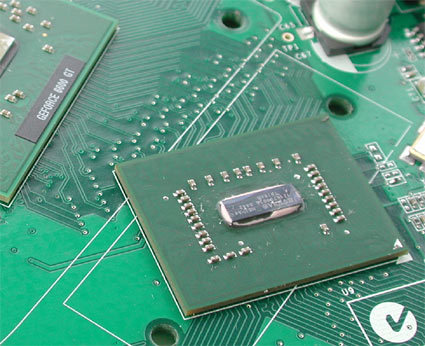Good 3D Performance at a Middling Price: GeForce 6600 Shootout
AGP Or PCI Express?
NV43 is NVIDIA's first "pure" PCI Express graphics processor, especially developed for the new PCI Express bus. In contrast, the GeForce 6800 and the older GeForce PCX GPUs are native AGP chips that NVIDIA makes PCI Express-capable by means of a translator: the so-called HSI bridge chip. For the AGP variations of the GeForce 6600, NVIDIA goes in the opposite direction, by having the bridge chip make the GeForce 6600 GPU AGP-compatible.
The GeForce 6600 graphics processor is a native PCI Express chip, so the NVIDIA HSI bridge chip translates AGP signals of the motherboard into PCI Express signals.
Which should you buy, you ask? The advantages of the new PCI Express bus over the AGP are currently more theoretical than real, but without a doubt the future belongs to the newer interface. The higher transfer speed and the ability to send and receive data simultaneously -AGP is only able to go one way at a time - are clear advantages for future applications and new games. Up until now, however, the industry has failed to provide the practical proof of all these advantages. At least in games - the main application of a 3D consumer graphics card - no advantages can be found at present for PCI Express graphics cards compared to AGP versions.
Adapting a computer to PCI Express is not cheap by any means. In addition to a new motherboard, most of the time you also need a new CPU, cooler, memory modules and potentially even a new power supply. Since the advantages of PCI Express are minimal, purchase of a new AGP graphics card is the most cost-effective way of improving performance on an existing computer for most gamers, assuming the PC's computing power has been kept up to current standards. Switching to PCI Express makes sense only when the PC is outdated and dragging, and it's time for a general overhaul.
Get Tom's Hardware's best news and in-depth reviews, straight to your inbox.
Current page: AGP Or PCI Express?
Prev Page GeForce 6600 Architecture, Continued Next Page Comparing The Test Candidates